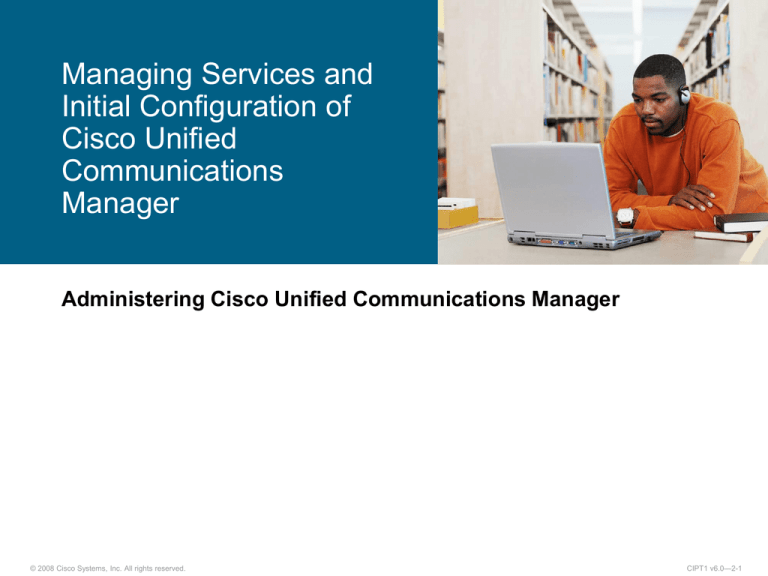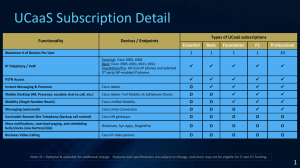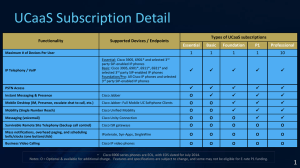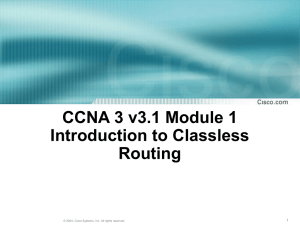
Managing Services and
Initial Configuration of
Cisco Unified
Communications
Manager
Administering Cisco Unified Communications Manager
© 2008 Cisco Systems, Inc. All rights reserved.
CIPT1 v6.0—2-1
Outline
Cisco Unified Communications Manager Initial Configuration
Cisco Unified Communications Manager Network Configuration
Options
Cisco Unified Communications Manager NTP and DHCP
Considerations
DNS Reliance of IP Phones
Cisco Unified Communications Manager Network and Feature
Services
Cisco Unified Communications Manager Enterprise Parameters
Cisco Unified Communications Manager Service Parameters
© 2008 Cisco Systems, Inc. All rights reserved.
CIPT1 v6.0—2-2
Cisco Unified Communications Manager
Initial Configuration
© 2008 Cisco Systems, Inc. All rights reserved.
CIPT1 v6.0—2-3
Cisco Unified Communications Manager
Initial Configuration
Configure network settings
NTP servers, DHCP services, remove DNS reliance
Verify network and Feature
services
Activate the necessary feature services and check
network services
Configure enterprise
parameters
Modify enterprise parameters as required
Configure service
parameters
Modify service parameters as required
© 2008 Cisco Systems, Inc. All rights reserved.
CIPT1 v6.0—2-4
Cisco Unified Communications Manager
Network Configuration Options
© 2008 Cisco Systems, Inc. All rights reserved.
CIPT1 v6.0—2-5
Network Configuration Overview
NTP
CUCM
Subscriber
DHCP/TFTP
CUCM
Publisher/DHCP
/TFTP
DNS Server
DNS
Master NTP
Reference Clock
Internet
© 2008 Cisco Systems, Inc. All rights reserved.
CIPT1 v6.0—2-6
Network Components
NTP stratum 1 server, directly connected to radio
receivers or atomic clocks.
Alternatively, a Cisco router can be configured as a
Master NTP reference clock master NTP server.
The Cisco Unified Communications Manager.
Publisher is the NTP client.
DHCP server provides IP address configuration and
TFTP server location to the IP phones.
DHCP and TFTP server
TFTP server provides device configuration files, ringer
files, and firmware upgrades to the IP phones.
A Cisco Unified CM server (typically publisher) can
provide both the DHCP and TFTP services.
DNS server
© 2008 Cisco Systems, Inc. All rights reserved.
Provides hostname to IP address resolution to the IP
phones and user PCs.
CIPT1 v6.0—2-7
Cisco Unified Communications Manager
NTP and DHCP Considerations
© 2008 Cisco Systems, Inc. All rights reserved.
CIPT1 v6.0—2-8
NTP Strongly Recommended
Master Reference Clock
Publisher
Subscriber
The publisher synchronizes to the external master clock source.
The subscribers get their clock source from the publisher.
© 2008 Cisco Systems, Inc. All rights reserved.
CIPT1 v6.0—2-9
Changing NTP Settings
Add or delete NTP servers on the publisher. (Read-only for
subscribers.)
© 2008 Cisco Systems, Inc. All rights reserved.
CIPT1 v6.0—2-10
DHCP Server Feature Support
DHCP server in Cisco Unified CM is designed to serve IP phones.
– Provides a subset of Windows 2000 Server DHCP
functionality.
– Sufficient for IP phone purposes.
– Not designed to serve other network devices (PCs, etc.).
– Only for smaller deployments (up to 1000 IP phones).
Only one DHCP server per Cisco Unified Communications
Manager cluster.
– DHCP server is a standalone server.
– No backup server exists.
Multiple subnets can be configured for each server.
© 2008 Cisco Systems, Inc. All rights reserved.
CIPT1 v6.0—2-11
Steps to Configure DHCP Phone Support
1. Activate DHCP Monitor Service.
2. Add and configure the DHCP server.
3. Configure the DHCP subnets.
© 2008 Cisco Systems, Inc. All rights reserved.
CIPT1 v6.0—2-12
Step 1: Activate DHCP Monitor Service
© 2008 Cisco Systems, Inc. All rights reserved.
CIPT1 v6.0—2-13
Step 2: Configure the DHCP Server
Designate a node
from the drop-down
menu to be the
DHCP server.
Option 150 specifies
the IP addresses of
the TFTP servers
to the phones.
All other required
entries default to 0.
© 2008 Cisco Systems, Inc. All rights reserved.
CIPT1 v6.0—2-14
Step 3: Configure the DHCP Subnet
Choose the DHCP server.
Configure subnet number and
primary address range to be
provided to the phones.
Configure secondary address
range as necessary (useful if
you have a block of reserved
addresses to exclude between
primary and secondary range).
© 2008 Cisco Systems, Inc. All rights reserved.
CIPT1 v6.0—2-15
DHCP Migration Considerations
When upgrading from Cisco Unified CM Release
4.x to 6.0:
No migration provided from Windows 2000-based DHCP
configuration to appliance-based DHCP configuration
Reprovisioning of the DHCP service required
– Using Cisco Unified Communications Manager Release 6.0
server
– Using the DHCP Server feature on the Cisco IOS router or
switch
– Use third-party DHCP servers
© 2008 Cisco Systems, Inc. All rights reserved.
CIPT1 v6.0—2-16
DNS Reliance of IP Phones
© 2008 Cisco Systems, Inc. All rights reserved.
CIPT1 v6.0—2-17
IP vs. DNS Considerations
Cisco Unified Communications Manager Release 6.0 can use DNS
names (default) or IP addresses for system addressing.
Advantages of using IP addresses
Advantages of using DNS
Does not require a DNS server
Simplifies management because of the
use of names instead of numbers
Prevents the IP telephony network from
failing if the IP phones lose connection to
the DNS server
Easier IP address changes because of
name-based IP paths
Decreases the amount of time required
when a device attempts to contact the
Cisco Unified CM server
Server to IP phone NAT possible
Simplifies troubleshooting
© 2008 Cisco Systems, Inc. All rights reserved.
CIPT1 v6.0—2-18
SCCP Call Flow with DNS
2) Signaling Protocol
IP Phone A
2) Signaling Protocol
3) RTP Media Path
1) DNS
Query/Response
IP Phone B
1) DNS
Query/Response
DNS Server
Before sending packets, IP phones will query the DNS server to
resolve the IP address of the Cisco Unifed CM server.
© 2008 Cisco Systems, Inc. All rights reserved.
CIPT1 v6.0—2-19
SCCP Call Flow Without DNS
1) Signaling Protocol
IP Phone A
1) Signaling Protocol
2) RTP Media Path
IP Phone B
No extra step (DNS lookup).
Higher availability (no dependency on the DNS server).
The recommendation is to remove the DNS reliance.
© 2008 Cisco Systems, Inc. All rights reserved.
CIPT1 v6.0—2-20
Removing DNS Reliance
Enables Cisco IP phones and other devices controlled by
Cisco Unified CM to contact the Cisco Unified CM without
resolving a DNS name
1. In Cisco Unified CM
Administration, choose
System > Server. The Find
and List Servers window
appears.
2. Click on a server name.
The Server Configuration
window appears.
3. Replace the hostname and
enter the IP address of the
server in the Host Name/IP
Address field. Click Save.
© 2008 Cisco Systems, Inc. All rights reserved.
CIPT1 v6.0—2-21
Cisco Unified Communications Manager
Network and Feature Services
© 2008 Cisco Systems, Inc. All rights reserved.
CIPT1 v6.0—2-22
Network and Features Services
Network Services
Feature Services
Services required for the Cisco Unified
CM system to function; for example,
database and platform services.
Services that enable certain Cisco
Unified CM application features; for
example, TFTP, call processing, or
serviceability reports.
Automatically activated after Cisco
Unified CM installation. Cannot be
activated or deactivated.
Must be activated manually using
Unified CM Serviceability > Service
Activation.
Use Unified CM Serviceability >
Control Center > Network Services to
stop, start, or restart services.
Use Unified CM Serviceability >
Control Center > Feature Services to
stop, start, or restart services.
© 2008 Cisco Systems, Inc. All rights reserved.
CIPT1 v6.0—2-23
Network Services
Categorized into the following groups:
Performance and monitoring services: Cisco CallManager
Serviceability RTMT, Cisco RTMT Reporter Servlet, etc.
Backup and restore services: Cisco DRF Master and Cisco DRF Local
System services: Cisco CallManager Serviceability, Cisco CDP, Cisco
Trace Collection tool, etc.
Platform services: Cisco DB, Cisco Tomcat, SNMP master agent, etc.
DB services: Cisco Database Layer Monitor
SOAP services: SOAP-Real-Time Service APIs, etc.
CM services: Cisco CallManager Personal Directory, Cisco Extension
Mobility Application, Cisco CallManager, and Cisco IP Phone Services
CDR services: Cisco CDR Repository Manager and CDR Agent
Admin services: Cisco CallManager administration
© 2008 Cisco Systems, Inc. All rights reserved.
CIPT1 v6.0—2-24
Feature Services
Categorized into the following groups:
Database and admin services: Cisco AXL Web Service, Cisco Bulk
Provisioning Service, Cisco TAPS Service
Performance and monitoring services: Cisco Serviceability Reporter,
Cisco CallManager SNMP Service
CM services: Cisco CallManager, Cisco TFTP, Cisco CTIManager, Cisco
Extension Mobility, etc.
CTI services: Cisco CallManager Attendant Console Server, Cisco IP
Manager Assistant, Cisco WebDialer Web Service
CDR services: Cisco SOAP–CDRonDemand Service,Cisco CAR
Scheduler, Cisco CAR Web Service
Security services: Cisco CTL Provider, Cisco Certificate Authority Proxy
Function
Directory services: Cisco DirSync
Voice Quality Reporter services: Cisco Extended Functions
© 2008 Cisco Systems, Inc. All rights reserved.
CIPT1 v6.0—2-25
Service Activation
To enable Cisco Unified Communications Manager
Release 6.0 feature services, perform the following tasks:
Access Cisco Unified CM Serviceability.
Go to Tools > Service Activation.
Select your server.
Enable the necessary services.
Go to Tools > Control Center – Feature Services and select
your server.
Verify that the configured services are up and running.
© 2008 Cisco Systems, Inc. All rights reserved.
CIPT1 v6.0—2-26
Service Activation Screenshot
4. Save and
perform settings.
Optional: Select default
services based on a
single-server configuration
5. Go to Control
Center – Feature
Services page.
1. Select the server.
2. Select the services
that should be
activated.
3. Deselect the
services that should
be deactivated.
© 2008 Cisco Systems, Inc. All rights reserved.
CIPT1 v6.0—2-27
Control Center Screenshot
Start, stop, restart,
and refresh
selected service.
Current status
Activation status
Service start time
and up time
Select service to
start, stop, or
restart.
© 2008 Cisco Systems, Inc. All rights reserved.
CIPT1 v6.0—2-28
Cisco Unified Communications Manager
Enterprise Parameters
© 2008 Cisco Systems, Inc. All rights reserved.
CIPT1 v6.0—2-29
Enterprise Parameters
Used to define cluster-wide system settings.
Apply to all devices and services in the same cluster.
After installation, enterprise parameters are used to set initial
values of device defaults.
Only change if you fully understand the feature that you are
changing or if instructed to do so by Cisco TAC.
© 2008 Cisco Systems, Inc. All rights reserved.
CIPT1 v6.0—2-30
Example of Enterprise Parameters
Parameter
Auto Registration
Phone Protocol
Description
Specifies the protocol with which
autoregistered phones should boot during
initialization.
Enable Dependency Determines whether to display dependency
Records
records.
Default value
SCCP
False
CCMUser
Parameters
These parameters are used to display or
hide certain user-configurable settings from
the CCMUser web page.
n/a
Phone URL
Parameters
URLs for IP phone authentication, directory
button, Services button, etc.
Hostnames are
used instead of
IP addresses
User Search Limit
This parameter specifies the maximum
number of users to be retrieved from a
search in the Corporate Directory feature on
the phone.
64
© 2008 Cisco Systems, Inc. All rights reserved.
CIPT1 v6.0—2-31
Changing Enterprise Parameters
1. From Cisco Unified Communications Manager Administration
page, choose System > Enterprise Parameters.
2. Update the appropriate parameter settings.
To view the description of a particular enterprise parameter,
click the parameter name.
To view the descriptions of all the enterprise parameters, click
the ? button.
3. To save the changes, click Save.
© 2008 Cisco Systems, Inc. All rights reserved.
CIPT1 v6.0—2-32
Enterprise Parameter Screenshot
2. Save the changes.
Default
setting
1. Select the new setting.
© 2008 Cisco Systems, Inc. All rights reserved.
CIPT1 v6.0—2-33
Phone URL Enterprise Parameters
When removing DNS reliance, change all hostnames in
URLs to IP addresses.
© 2008 Cisco Systems, Inc. All rights reserved.
CIPT1 v6.0—2-34
Cisco Unified Communications Manager
Service Parameters
© 2008 Cisco Systems, Inc. All rights reserved.
CIPT1 v6.0—2-35
Service Parameters
Service parameters for Cisco Unified Communications
Manager allow you to configure parameters for different
services. Examples for service parameters of the Cisco
Unified Communications Manager call-processing
service are:
T302 timer to speed up dialing
Enable call detail records
Define extension mobility maximum login time
Define attendant console username
Define voice media-streaming application codecs
© 2008 Cisco Systems, Inc. All rights reserved.
CIPT1 v6.0—2-36
Example of Service Parameters
Parameter
Description
Default value
CDR Enabled Flag
This parameter determines whether call
detail records (CDRs) are generated.
False
Station KeepAlive
Interval
This parameter designates the interval
between KeepAlive messages sent from
Cisco IP phones to the primary Unified CM.
30s
T302 Timer
This parameter specifies an interdigit timer
for sending the SETUP ACK message.
When this timer expires, Cisco Unified CM
routes the dialed digits.
15s
Automated Alternate This parameter determines whether to use
Routing Enable
automated alternate routing when the
system does not have enough bandwidth.
False
Change B-Channel
Maintenance Status
(Click Advanced
button first.)
n/a
© 2008 Cisco Systems, Inc. All rights reserved.
This parameter allows Cisco Unified CM to
change individual B-Channel maintenance
status for PRI and CAS interfaces in real
time for troubleshooting.
CIPT1 v6.0—2-37
Changing Service Parameters
1. From Cisco Unified CM Administration page, choose System >
Service Parameters.
2. Select the Server and choose the Service.
3. Update the appropriate parameter settings.
If you cannot find the parameter, click the Advanced button to
display hidden parameters.
4. To save the changes, click Save.
© 2008 Cisco Systems, Inc. All rights reserved.
CIPT1 v6.0—2-38
Service Parameter Configuration Screenshot
Select server.
Select service.
© 2008 Cisco Systems, Inc. All rights reserved.
CIPT1 v6.0—2-39
CallManager Service Parameters Screenshot
Optional: Click Advanced to show
hidden service parameters.
2. Save the changes.
Verify/configure
service settings
Default
setting
1. Select the new setting.
© 2008 Cisco Systems, Inc. All rights reserved.
CIPT1 v6.0—2-40
Summary
Cisco Unified Communications Manager initial configuration includes
network configuration, activation of feature services, and enterprise and
service parameter configuration.
Cisco Unified Communications Manager network configuration options
include NTP configuration, DHCP server configuration, and using DNS
versus IP addresses.
The Cisco Unified Communications Manager DHCP service is designed
to serve IP phones.
In order to avoid DNS reliance of IP phones, change hostnames to IP
addresses.
Network services are automatically activated, while Feature services are
activated by the Cisco Unified Communications Manager administrator.
Enterprise parameters are used to define cluster-wide system settings.
Service parameters are used to configure parameters of specific
services.
© 2008 Cisco Systems, Inc. All rights reserved.
CIPT1 v6.0—2-41
© 2008 Cisco Systems, Inc. All rights reserved.
CIPT1 v6.0—2-42









